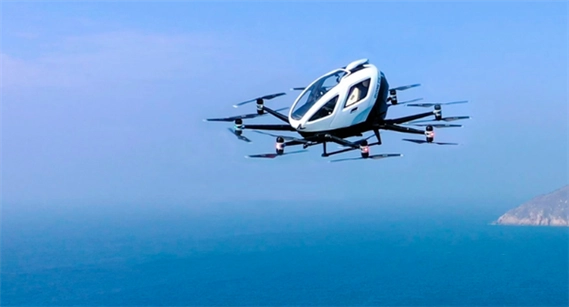The flying car industry has achieved a significant breakthrough. On October 13th, EHang Holdings Limited (Nasdaq: EH), commonly referred to as “EHang”, announced that its autonomously developed EH216-S Unmanned Aerial System (UAS) for passenger transport has officially received the Type Certificate (TC) from the Civil Aviation Administration of China (CAAC). This signifies that the design of EH216-S fully complies with the safety standards and airworthiness requirements set by the CAAC, making it qualified for commercial operations.
This authentication by EHang has excited the eVTOL (electric vertical takeoff and landing aircraft, popularly known as “flying car”) industry. Insiders believe this will significantly catalyze the eVTOL industry. EHang stated that its innovation and success not only set an important benchmark for eVTOL airworthiness certification in China and globally but also marks a significant milestone in urban air mobility operations.
Following this announcement, EHang’s stock surged by 123% in pre-market trading. By the end of the trading day, the increase settled to 18.71%.
The dream of “taking a flight” is gradually becoming a reality.
For flying cars to be commercially viable, they must obtain airworthiness certification from the aviation authority. On October 13th, the TC award ceremony for the EH216-S was held at the Beijing Civil Aviation International Conference Center, where the CAAC officially granted the certificate to EHang.
EHang introduced that the EH216-S, a revolutionary innovation in terms of technology and product, greatly differs from traditional aircraft in technical architecture, design, performance, functions, operational modes, and flight environment. The CAAC and EHang upheld stringent standards and innovated based on traditional aviation rules, formulating guidelines fitting the technical characteristics of EH216-S.
Yin Shijun, the Chief Engineer of the CAAC, mentioned that since accepting the EH216-S TC project in 2021, the CAAC has attached great importance to it and actively explored the evaluation methods for unmanned aerial systems, ensuring a safe and steady approval process.
EHang’s founder, chairman, and CEO, Hu Huazhi, expressed his gratitude towards the CAAC, the review team, and all of EHang’s employees. “Thanks to everyone’s relentless efforts, our EH216-S, a globally pioneering eVTOL, has achieved its certification. This is a vivid chapter in the history of civil aviation. With the TC as our new starting point, we will prioritize safety and initiate the commercial operations of the EH216-S.”
It’s worth noting that EHang announced on July 12th a $23 million private placement agreement with strategic investors, led by the founder of South Korea’s SM Entertainment, Lee Soo-man. Besides this capital increase, EHang and Lee Soo-man plan to jointly promote urban air transportation business in the Asia-Pacific region.
In recent times, the flying car industry has received several positive policy updates.
On October 10th, China’s Ministry of Industry and Information Technology, along with three other departments, released the “Green Aviation Manufacturing Development Outline (2023-2035)”. The document emphasizes sustainable aviation fuel, commercial applications for electric general aviation aircraft, pilot operations for eVTOLs, and feasibility tests for hydrogen-powered aircraft.
Bank of China Securities remarked that while the eVTOL industry might seem submerged from the public view, its maturity might surpass market expectations. The recent guidelines further affirm the positive momentum.
Additionally, EHang announced a strategic investment in Shenzhen Xinsijie Technology Co. Ltd., a solid-state lithium metal battery tech company, on September 20th. Founded in 2020, Xinsijie focuses on the research and production of solid-state lithium metal batteries and already has a production line of 200MWh.
